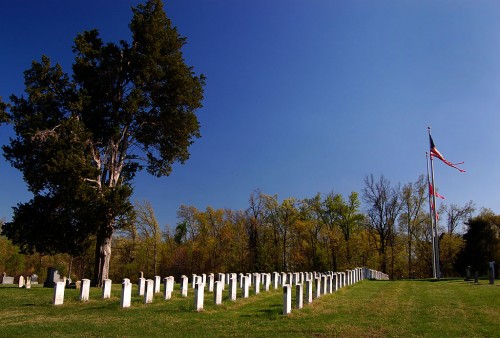 In the shadow some of the most disgracefully tattered flags I’ve seen flying in a public venue is a fascinating memorial to the Confederate dead from Stoddard County, Mo.
In the shadow some of the most disgracefully tattered flags I’ve seen flying in a public venue is a fascinating memorial to the Confederate dead from Stoddard County, Mo.
Larry Arnold’s idea
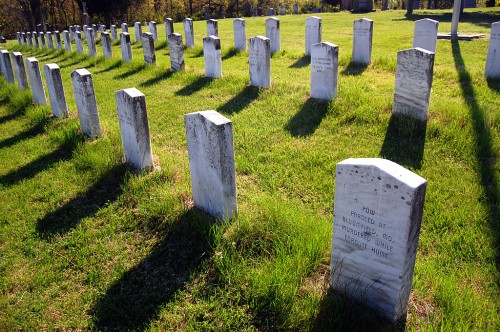 Larry Arnold, a Civil War buff from Dexter, Mo., saw a Civil War tombstone in a St. James, Mo., cemetery that had the soldier’s name and normal dates, but on the back was inscribed, “killed by the Yankees at the Battle of Booneville, Mo. Whenever he saw a military stone after that, he was always disappointed not to see the detail of the serviceman’s death.
Larry Arnold, a Civil War buff from Dexter, Mo., saw a Civil War tombstone in a St. James, Mo., cemetery that had the soldier’s name and normal dates, but on the back was inscribed, “killed by the Yankees at the Battle of Booneville, Mo. Whenever he saw a military stone after that, he was always disappointed not to see the detail of the serviceman’s death.
The Stoddard County’s Confederate Memorial’s website tells what happened next:
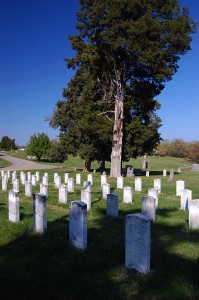 When Jim McGhee and Jim Mayo published their book, “Stoddard Grays“, (an informational book about Confederate soldiers from Stoddard County), Arnold started to get an idea. “I thought it would be neat to order grave markers for the 117 plus Stoddard Countians that died during the war and inscribe where and how they died on the back.
When Jim McGhee and Jim Mayo published their book, “Stoddard Grays“, (an informational book about Confederate soldiers from Stoddard County), Arnold started to get an idea. “I thought it would be neat to order grave markers for the 117 plus Stoddard Countians that died during the war and inscribe where and how they died on the back.
“When I conceived the idea there was 117 known Stoddard Countians. We now know of 121 soldiers, 9 civilians–‘Political’ prisoners who died in prison at Alton, Illinois, plus 22 non-Stoddard Countians who are buried in this location; their home counties are inscribed on the back of the stones.”
“Even though their bodies lie from Mine Creek, Kansas, in the West, to Petersburg, Virginia, to the East, on the battlefields of the South, and under the former POW camps of the North, their names and sacrifices will once again be remembered and spoken of in their home county they loved so much and were willing to die for.”
The Minton Brothers
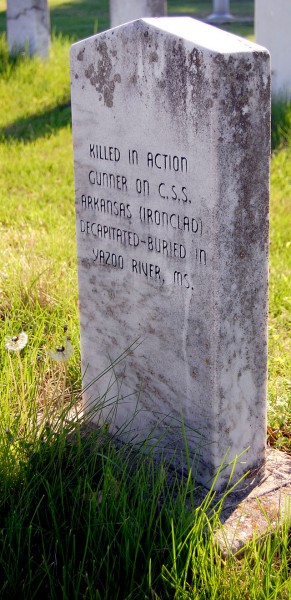 Two stones bring home the horrors of war.
Two stones bring home the horrors of war.
The website describes Stephan Minton, age 16, as “a curious Irish lad whom Capt. Brown made reference to in the ship’s log. Minton had stuck his head out of a gunport for a view and was immediately decapitated by an enemy shell.”
“I can’t, Sir. That’s my brother”
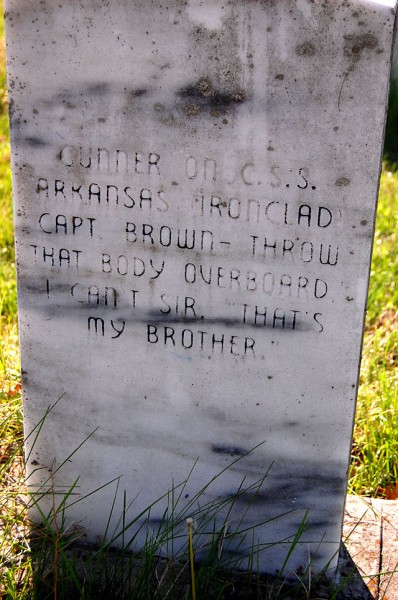 The Captain unknowingly ordered another Missouri gunner, Smith Minton (Stephan’s brother) to “throw that body overboard.”
The Captain unknowingly ordered another Missouri gunner, Smith Minton (Stephan’s brother) to “throw that body overboard.”
Smith Minton’s reply was, “I can’t sir, that’s my brother.” Smith Minton would survive the war but die of illness in Texas where he lies buried in an unmarked grave. While the Minton brother’s remains lie elsewhere, their memory lives on in Stoddard County where they enlisted in 1861.
Terrorist or freedom fighter?
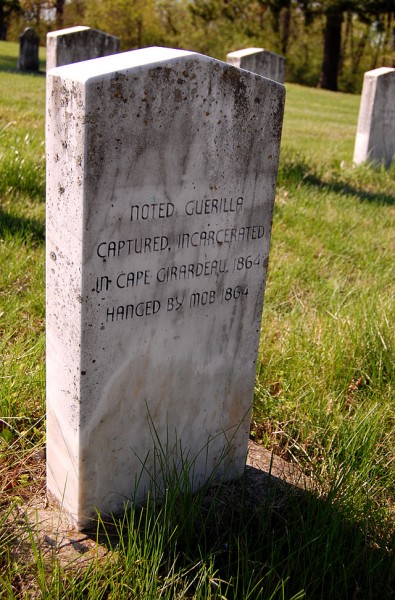 It’s been said that one man’s terrorist is another man’s freedom fighter. That’s certainly the case with Pvt. John Fugate Bolin, a “noted guerilla captured, incarcerated in Cape Girardeau, 1964; hanged by mob 1864.”
It’s been said that one man’s terrorist is another man’s freedom fighter. That’s certainly the case with Pvt. John Fugate Bolin, a “noted guerilla captured, incarcerated in Cape Girardeau, 1964; hanged by mob 1864.”
The 2010 Cape Girardeau Historic Preservation Month Walk had this to say in its entry on the Common Pleas Courthouse:
During the Civil War, the Union provost marshal had his headquarters at the courthouse. The provost marshal was, in effect, the military governor for the area. The jail in the bottom of the building was used for disloyal locals, occasional captured rebels, disorderly Union soldiers, and people awaiting trials. In one episode, captured rebel guerrilla leader John Fugate Bolin was dragged from his cell by local people and soldiers and lynched from a farm gate on Bloomfield Road in retaliation for murders of unarmed Unionists.
Defending Missourians from “savage invaders”
The Missouri Partisan Ranger Virtual Museum & Archives has a different perspective on guerilla forces:
“These men rode hard and defended the innocent citizens of Missouri from the slaughter and carnage that had been committed by Federal occupational forces sent by Abraham Lincoln.
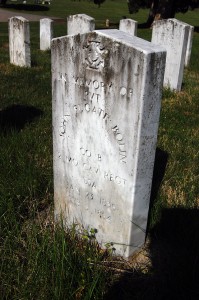 “Many Northern histories and spin doctors consider the Missouri Partisan Ranger to be bushwhackers and thieves. But in reality, they were only waging the type of war that had already been committed against them and their families for over a decade.
“Many Northern histories and spin doctors consider the Missouri Partisan Ranger to be bushwhackers and thieves. But in reality, they were only waging the type of war that had already been committed against them and their families for over a decade.
“The Federal occupational troops sent by Lincoln came from Iowa, Illinois, Michigan, Wisconsin and mainly Kansas. They raped, pillaged, burned and destroyed much of Western, West Central and South West Missouri.
“The Missouri Partisan Rangers were at times the only defense the people of Missouri had from these savage invaders. Without doubt, the so called Federal armies were indeed illegal occupational invaders who simply had no right to occupy and violate Missouri’s autonomy.
“As issued on March 13, 1862 in Order Number 2, The Missouri Partisan Rangers were given ‘No Quarter’ when they were captured. Murder and death were the occupational armies sole solution.
“And in return, No Quarter was given to the enemy of The Missouri Partisan Ranger.”
Location of Bloomfield Cemetery
View Stoddard County Confederate Memorial in a larger map

That war will never end.
Cape’s Confederate memorial which once graced the median in the approach to the old bridge now sits adjacent the stone Union soldier on courthouse park.
Oh, Ken, you’ve done it again! This post makes me feel sooo guilty, because I haven’t written about that wonderful cemetery with the tattered flag. I took my sister there a couple of years ago; she went to school in Alabama, and she was HORRIFIED by the flag! She offered to buy a new one, but I never found out who to contact. My fiance wants to just go by and replace the U.S. flag ourselves. I think there’s a Confederate flag flying, too.
Every time I go, I’m fascinated by the writing on back of the monuments, telling how the soldiers died. It’s a beautiful, peaceful cemetery on top of a secluded hill on the edge of Bloomfield.
This year, our North Stoddard Countian Progress edition theme will be about the effects of the Civil War on this region. The Bloomfield stories will be relatively easy to find, since that county seat played a big part in the battle. I’ll have to scrounge to find Civil War information on Advance, since it didn’t come into being until 1881. Lakeville may yield some information.
Thanks again for branching out into the counties surrounding Cape. We’re all connected, ya know!
Madeline,
We could work out some kind of deal if you want me to slip you some Stoddard county stories under the table.
Just write your request on a 50-dollar bill and mail it to me.
Thanks for a great article Ken. There is a Cemetery in Crowley, Tx that has some Civil War graves. The Cemetary association marks these graves with Confederate flags. They are putting up a memorial on one end of the cemetery to honor ALL who served in the Civil War.
Glad you enjoyed it. I was a little afraid someone might take offense at a Memorial Day posting about the guys who fought for The Other Side.
Thanks, Ken.
Over the weekend, I once again looked through the book, “Images of the Past in the City of Roses”.copyright 1993 by the Missourian. Chapter 9 reviews the military. It begins with Frederick Hahn who “at the time of his death in 1936 was the oldest Civil War Veteran in C ape County.” (paraphrased). The book contains a wealth of information. Can’t wait for your book!
Wonderful history lesson Ken. Wish I had known of some of these places when I spent the first 33 years of my life in Cape.
Joe Whitright “45”
Ken:
I had NO idea that was there. I am going to have to make it a point to visit Bloomfield,mo and see that cemetery.
Please write a book of local history with the stories included. I love ancestry and visit lots of cemeteries. I will be one of the first ones in line to have you sign the book for me. I save EVERY email and photo you send out…….just very hard to put it in book form.
Joy,
That’s why there’s no book yet. It’s hard to translate the blog into a book format.
I AM working on something that I hope to have out before the end of the year.
The other problem is that I don’t really write history. I just jot down mental meanderings that have pictures attached.
Ken,
Fascinating article. I somehow stumbled across this website and have been a daily reader since. Thanks so much for the trip down memory lane. Makes me realize how much I miss Cape. Thanks again!
Thank you for this website! My great grand father Linnboyd Adams was a prisoner at Alton. Was suppose to be released. But, can’t find and his wife. He went by Linnboyd, L.B. and Linboid.
This website gave me more knowledge have our ancestors back there,
Patricia
Good article, Ken. Thanks for the link!
My 3 times great Grandfather fought in this battle and was taken captive and sent to Alton Prison. In researching his military history I came across this website and was very impressed.
These men not only gave their lives but were virtually sent to slaughter. They had basically no training to fight and many were sent to fight with only farm tools as weapons and no proper protection or uniforms.
These were men defending their families with all the odds against them yet they fought honorably.
What a wonderful memorial. My ancestor Jacob Kinder was in the Stoddard Co Rangers. And I never learned if he went to Alton. We have never found his burial place.
Carole Kinder Watkins.
Where can I get a list of the Confederate soldiers in the cemetery?
Here is a site that tells the history of the memorial and lists the names.